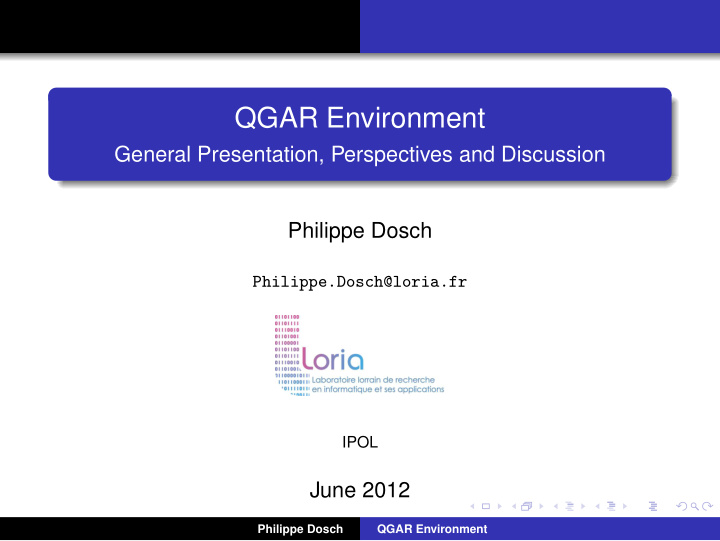



. QGAR Environment General Presentation, Perspectives and Discussion . Philippe Dosch Philippe.Dosch@loria.fr IPOL June 2012 . . . . . . Philippe Dosch QGAR Environment
. Summary . QGAR Overview 1 . . Use-case 2 . . Use: History, Future 3 . . . . . . Philippe Dosch QGAR Environment
QGAR Overview Use-case Use: History, Future . Summary . QGAR Overview 1 . . Use-case 2 . . Use: History, Future 3 . . . . . . Philippe Dosch QGAR Environment
QGAR Overview Use-case Use: History, Future . QGAR Purposes Collect and capitalize the works of many researchers Ease the development of new applications by regrouping state-of-art implementations of basic structures and graphics precessing algorithms Provide an environment to tune applications and evaluate their performances Spread our know-how in the field of graphics recognition . . . . . . Philippe Dosch QGAR Environment
QGAR Overview Use-case Use: History, Future . Architecture binarization binary Q Q images text/graphic segmentation G G dashed lines detection A A string detection grey level R R images thin/thick segmentation L G vectorization I U B I symbol recognition vectorial images etc. . . . . . . Philippe Dosch QGAR Environment
QGAR Overview Use-case Use: History, Future . QGAR Library Approx. 150 classes, written in C++ Image processing Binarizations, mathematical morphology, distance transformations, skeletonization, convolutions, Gradients and Laplacians, edges detection... Graphical processing Polygonal approximations, Freeman chains, connected components, vectorization... Data structures Images, graphs, trees, histograms, masks... Tools Files input/output, object serialization, classification... . . . . . . Philippe Dosch QGAR Environment
QGAR Overview Use-case Use: History, Future . QGAR Applications Applications built from the basic building blocks from the QGAR Library Independent applications Interactive call from the QGAR graphical user interface Batch call from the command line Around 10 applications are available binarizations, text-graphic separations, thin-thick separations, text extraction, vectorizations, image degradation, symbol recognition... . . . . . . Philippe Dosch QGAR Environment
QGAR Overview Use-case Use: History, Future . QGAR GUI User interface Process invocation and parameters tuning Results visualization Interactive image editing Application import through a plug-in architecture Data transfer using files formats PBM+, DXF, SVG . . . . . . Philippe Dosch QGAR Environment
QGAR Overview Use-case Use: History, Future . Software Features About 170,000 lines of C++ Unit testing CPP Unit Available under Linux/Windows Computations not distributed Registered as free software by the French agency for software protection (APP) Licensed under LGPL/QPL Website http://www.qgar.org . . . . . . Philippe Dosch QGAR Environment
QGAR Overview Use-case Use: History, Future . Summary . QGAR Overview 1 . . Use-case 2 . . Use: History, Future 3 . . . . . . Philippe Dosch QGAR Environment
QGAR Overview Use-case Use: History, Future Demo . Original image . . . . . . Philippe Dosch QGAR Environment
QGAR Overview Use-case Use: History, Future Demo . Text-graphic separation: Text layer . . . . . . Philippe Dosch QGAR Environment
QGAR Overview Use-case Use: History, Future Demo . Text-graphic separation: Undetermined layer . . . . . . Philippe Dosch QGAR Environment
QGAR Overview Use-case Use: History, Future Demo . Text-graphic separation: Graphic layer . . . . . . Philippe Dosch QGAR Environment
QGAR Overview Use-case Use: History, Future Demo . Thick-thin separation: Thick layer . . . . . . Philippe Dosch QGAR Environment
QGAR Overview Use-case Use: History, Future Demo . Thick-thin separation: Thin layer . . . . . . Philippe Dosch QGAR Environment
QGAR Overview Use-case Use: History, Future Demo . Recognized symbols . . . . . . Philippe Dosch QGAR Environment
QGAR Overview Use-case Use: History, Future Demo . 3D Reconstruction . . . . . . Philippe Dosch QGAR Environment
QGAR Overview Use-case Use: History, Future . Summary . QGAR Overview 1 . . Use-case 2 . . Use: History, Future 3 . . . . . . Philippe Dosch QGAR Environment
QGAR Overview Use-case Use: History, Future . A Brief History Project started in 2000 when There was a need of works capitalization No such open source environment was available for our needs Half a dozen people were motivated for this environment creation The great period: 2000–2005 Many contributors: students, researchers, engineers Many users Used in several research projects and industrial contracts . . . . . . Philippe Dosch QGAR Environment
QGAR Overview Use-case Use: History, Future . A Brief History The hard times: 2006–now Evolutions (internal, external) are time-consuming No “permanent” maintainer New students use to work with Mathlab: less users, less contributors for our environment Even if... Mathlab (or other general scientific softs) does not address all our specific needs (but our environment does?) The environment is still functional (but for how long?) Still provide a (good) visibility of our know-how and generate partners contacts And now? . . . . . . Philippe Dosch QGAR Environment
QGAR Overview Use-case Use: History, Future . The future? IMHO, we have less and less time to devote to research Software engineering require time and skills A critical number of users/contributors is required to make live such an environment Since 2000, new softwares and tools are available: not “perfect”, but useful So, the future? . . . . . . Philippe Dosch QGAR Environment
QGAR Overview Use-case Use: History, Future . The future? Devote efforts and time to our environment? How? Use as much as possible standard tools. Great, and for specific purposes? Use one or several of the many great environments presented today? Each additional use of these could become a problem (license, bug fixes, perenity...), but why not as... ...We could also work on a common environment, involving several teams (but also needs...) No final answer for now... Charon (presented this morning), for technical aspects? . . . . . . Philippe Dosch QGAR Environment
Recommend
More recommend